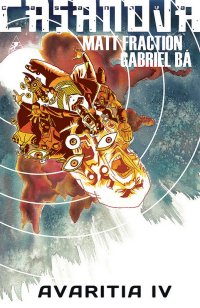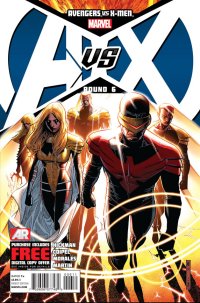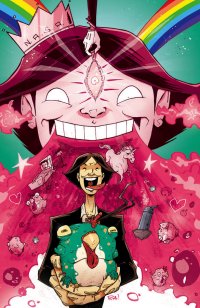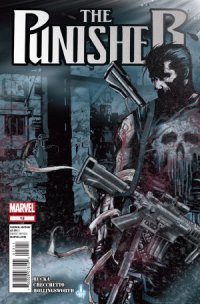Casanova: Avaritia #4 (Marvel, $4.99)
By Adam Prosser
“Yeah, I’m kind of on to the next thing now.” –Casanova Quinn
In 1965, while acting as editor for the British SF magazine New Worlds, Michael Moorcock started writing what was eventually published as the novel The Final Programme. While it can be superficially described as a hip, tongue-in-cheek spy story of the kind that was becoming hugely popular thanks to James Bond, the book deviated from being a typical action adventure pretty quickly. Beginning as another iteration of Moorcock’s “eternal champion” idea—in fact, the first part of the novel is basically a rewrite of the Elric stories as a spy thriller—it quickly spun off in much stranger directions, eventually leading to the end of the world. It got better in time for the sequels, which became progressively stranger and more experimental, eventually culminating in a seeming metafictional revelation that either made sense of or completely destroyed the Jerry Cornelius mythos, depending on your viewpoint. Jerry became a mascot for Strange Worlds and then went on to influence others; Moorcock encouraged other writers to use him, in what could be considered one of the earliest “shared world” experiments, and the idea of using the secret agent action-adventure story as a vehicle for absurdism and deconstruction became common by the end of the 60s, especially in England—see for example The Prisoner, or the berserk later seasons of The Avengers. A figure of anarchy and chaos within his own stories, Jerry had broken out to wreak the same havoc on pop culture at large, and he still echoes through fiction to this day. Comic books in particular have been hugely influenced by Moorcock’s work in general (Alan Moore’s a personal friend of Moorcock, and Jerry Cornelius popped up in the last few volumes of LoEG.)
I mention this because I started reading Matt Fraction, Gabriel Ba and Fabio Moon’s Casanova before discovering Jerry Cornelius, but now that I have it’s pretty obvious that Casanova Quinn is a fairly thinly-disguised version of Jerry, here interpreted as a highly rebellious dimension-hopping agent of S.H.I.E.L.D. and locked into a more conventional narrative. Of course, this “more conventional narrative” is still pretty bizarre compared to most comic books, themselves a pretty bizarre medium.
This issue concludes the “Avaritia” arc and seems to be clearing the decks for the next phase of the series. A former associate of Casanova’s has done a heel turn (well, it’s not really that surprising since he started out as a bad guy) and is bringing the E.M.P.I.R.E. organization down in flames. Suddenly everyone wants to kill Casanova, as the E.M.P.I.R.E. ship plummets from the skies and everything explodes. There’s…really not much more to the plot than that, but Fraction and Ba (the current artist—he alternates arcs with his brother Moon) always bring a wild, unconventional touch to Casanova, and here this straightforward action movie third act is rendered in some terrifically imaginative ways, including an ultra-slo-mo climax that crosscuts between multiple characters in a way that Zack Snyder only wishes he could pull off.
And as always, there’ll be metafiction. It’s become clear with this storyline that Fraction’s exploring the creative process itself, with Casanova functioning as a weirdly destructive muse, forcing his creator to move forward and burn his bridges behind him. Here he escapes the entanglement of his supposedly eternal struggle against his archnemesis Newman Xeno (partly by saving the life of a version of Xeno from an earlier point in time, and seemingly erasing the present-day, evil Xeno from history…did I mention this series was bizarre?) even while E.M.P.I.R.E., with whom he’s hardly had a warm and friendly relationship, literally goes down in flames. Cass has even been destroying the metafictional integrity of his world throughout this storyline by shattering the fourth wall—in this issue he dismisses a villain’s grudge by saying “That was a lifetime, two miniseries and a whole other publisher ago!” Right before Charles Dickens (“because why not?”) appears to give a narrative recap. Of current comics, only The Goon approaches this kind of lunacy, but the fact that Casanova does it under the guise of pretending to be a serious action-adventure story makes it all the more subversive.
Jerry Cornelius predates punk rock, but he anticipates it so well that it’s tempting to credit him as a founding father of the movement: the literal father-killing, the freewheeling anarchy, the deep well of compassion and woundedness disguised as apathy and amorality, the anything-goes aesthetic. If there’s a significant difference between him and Casanova, it’s that Cass is post-punk and has the benefit of several decades of hindsight. Cass, like Jerry, doesn’t just destroy his old relationships, he literally breaks free of the story he’s in, and where he ends up at the end of this issue (which could actually function as a pretty effective finale for the series) suggests that he might soon be dabbling in the same kind of metafictional awareness as Jerry Cornelius did. Because why not?
Rating: 




Out of a Possible 5 Stars
 Avengers Vs X-Men #6 of 12 (Marvel, $3.99)
Avengers Vs X-Men #6 of 12 (Marvel, $3.99)
By Jeb D.
I realize that John Romita, Jr. is as highly regarded a penciller as the modern superhero comics industry has, and rightly so: he’s got pedigree and legacy; he is one of the few guys out there that can actually consistently turn out monthly work on time; and he’s got a great feel for action. But ongoing superhero comics aren’t action movies: they’re a mixture of storytelling elements, including action, fantasy, mystery, thriller… and soap opera. And soap operas have two compelling elements: the melodrama of interlocking relationships (perfected, of course, in the Claremont-era X-Men), and the aesthetics of beauty. I’m not talking about the frequent overuse of sexual titillation in comics: the soap opera aesthetic is not about overt sex, but about aspiration and luxury, from the settings, trappings, and costumes, right up to the impossibly perfect smiles, hair, and physiques of the performers. So I doubt it’s a coincidence that what feels like the first real burst of energy in this series comes in an issue where the Kirby-like blockiness of Romita is exchanged for the lusher, looser textures of Olivier Coipel; and Jonathan Hickman’s script offers him plenty of opportunity to show off the godlike nature of his cast.
Superheroes raising their sights above the latest punchout, and deciding to use their vast powers to enforce a “better” world has, of course, been the source of many ambitious and rewarding series of the past few decades, from Marvelman to Squadron Supreme to The Authority and beyond; Avengers vs X-Men is in no danger of joining that pantheon ( at least not yet), but it does a respectable job of mining the same territory. This latest iteration has the advantage of employing a nicely diverse cast of familiar favorites, with a psychically hyper-aware Cyclops leading a Phoenix-ized team that also includes Namor, Emma Frost, Colossus, and Magik, to force a squabbling humankind to craft a “better world” in the face of the usual arguments about freedom and free will coming from Captain America, T’Challa, Barack Obama, and sundry others. The Phoenix power is a convenient way to make Cyke’s team the sort of irresistible force that not even Thor can effectively oppose; along the way we get caught up on Magneto and Xavier, spend a disquieting interlude in K’un Lun, and we end with the introduction of a particularly “chaotic” monkey wrench about to be tossed into the story’s gears.
I should also mention that this is another Marvel comic whose purchase gives you free access to a supplemental “Infinite” digital comic, by Mark Waid, Yves Bigerel, and Carlo Barberi. It’s a fairly static story of Cyclops taking his introspection to the moon to psychically swap Phoenix anecdotes with the memory of Jean Grey; the pseudo-animation of the “Infinite” format does add a bit of sparkle.
I don’t know that Avengers vs X-Men #6 works particularly well as a standalone comic, but as the most provocative chapter in what has, so far, been a relatively mundane crossover event, I give it high marks.
Rating: 




Out of a Possible 5 Stars
Mars Attacks #1 (IDW, $3.99)
CHEW #27 (Second Helping Edition) (Image, $2.99)
By Graig Kent
The 90’s left a pretty bad taste in the mouths of many a comic book fan, collector or reader. From “bad girls” to “grim ‘n’ gritty” to “new universes” to “indie renaissance” it was a time of great prosper and crappy, crappy comics. The kale of this comic book salad was most certainly the “gimmick” book. Whatever it took to attract attention and distinguish one’s comic self on the stands, from alternate covers to “chromium” to trade paperbacks polybagged with exclusive zero issues. No publisher was exempt, each one frequently sousing oneself in “eau de collector’s item” to the point where the not only did the product leave a bad aftertaste, but it stunk up front too.
I’m being only mildly hyperbolic. Some good came out of the ’90’s comic boom. The growth of mature readers comics, the stability of independent publishers, and the resurgence of writer-driven comics…
But the “gimmick” never truly died. It’s stuck with us, albeit in a more controlled state. I’ve personally picked up books with “foil embossing” and even a “scratch-off” section on the cover lately. Hell, I picked two more somewhat gimmicky books this week. Yet strangely, it’s not tasting so bad. Perhaps we’ve learned how to prepare that kale so that even if it doesn’t necessarily taste great, it’s something we’ll actually want to eat.
With Mars Attacks #1, the most recent stab at the notorious Topps trading card property, IDW has really reinvented the gimmick cover, to a certain degree anyway. It’s distributing its first issue with not one, not two, not even five or ten but 55 different covers. While that may seem excessive (and it is, boy howdy), it’s also perhaps the most fitting use of the multiple-covers idea, since each of the 55 reprints a different trading card image from the original Mars Attacks trading card set. It’s also an interesting strategy because, for a smaller press like IDW, since how likely is it that most retailers are going to order enough copies to get a full compliment? Not very. So it’s not so much a push for retailers to double or triple their order in hopes that slavish fanboys will buy multiple covers, but instead the expectation is that any interested reader will choose a cover, perhaps even at random. Where it gets clever is instead the publisher is offering all 55 covers in a collector’s box (modeled after the original Mars Attacks trading card box design). It’s not something I want, or would buy, but I was actually impressed (until I saw the price tag) . The appeal of trading cards, but in comic book form.
As for the comic itself, it’s.. well, it’s not bad actually. It doesn’t quite live up to the nostalgic splendor of the original card or the flash and dazzle of “55 Variant Covers!” but writer John Layman has broken down the Mars Attacks concept and put together a story idea that tries to take the whole thing seriously, or at least seriously enough, while putting an original spin on it.
I don’t really have a lot of history with Mars Attacks. The cards were out long before I was born. My only real frame of reference is Tim Burton’s whackadoo adaptation (which I happen to like, also understanding that my opinion not the consensus), so it’s easy to forget (or not know at all) that the original Mars Attacks was itself quite earnest, presenting somewhat intense, horrific and decidedly stimulating imagery as huge brained Martians attack the Earth with flying saucers, ray guns, and mutated bugs.
Layman’s story isn’t an adaptation of the card series, but a tinkering with the general concept. This first issue acts as the set-up for things to come. In the early 1960, far, far away from Madison Avenue and Don Draper, a perhaps benign journey to Earth by four Martians takes a fateful detour after colliding with a space capsule and crash landing deep in the Mid-West. Things do not go well, for anyone. While the remainder of the series will be set in modern day, it’s a nice bow to the spirit of the source to backtrack to the 60’s for the story’s inception.
Layman is joined by John McCrea, best known for his various teamings with Garth Ennis over the years. If there’s a guy meant to draw, gruesome big-brained aliens with deadly flesh-disintegrating ray-guns, McCrea is that guy. He seems to relish in the task of showing Martians shoot-up humans and vice versa. It’s what we’re all here for anyway, isn’t it?
Mars Attacks isn’t a needed comic, it’s not a necessary comic. The idea of the comic (not the story) does seem almost trenched in the concept of its “55 covers” gimmick. It’s a property that IDW is hoping not only has a loyal nostalgia base, but enough legs as a name alone to lure in the curious. It’s true that popular culture, especially in North America, is rapidly becoming about maintaining or reinvigorating properties, trademarks and copyrights, maximizing the revenue it can generate without a whole lot of “art” to show for it, however sometimes pure entertainment can be enough to justify the absence of art.
 Layman, though obviously work-for-hire on Mars Attacks, isn’t solely a slave to the machine though. If the snake’s going to eat its own tail, Layman’s got his own mouse that runs free because of it with CHEW. I’ve been reading CHEW from issue one and with each passing month, I grow to enjoy, like and appreciate it more. It’s a sci-fi comedy detective procedural that is unlike anything on the stands, on TV or in the movies. It’s an original idea that continues to maintain its originality even into its third year.
Layman, though obviously work-for-hire on Mars Attacks, isn’t solely a slave to the machine though. If the snake’s going to eat its own tail, Layman’s got his own mouse that runs free because of it with CHEW. I’ve been reading CHEW from issue one and with each passing month, I grow to enjoy, like and appreciate it more. It’s a sci-fi comedy detective procedural that is unlike anything on the stands, on TV or in the movies. It’s an original idea that continues to maintain its originality even into its third year.
What impresses me most about CHEW is its world building. Layman has created a rich, intricately thought-out environment, populated with a broad cast of interconnected characters, all partaking in a series of stories that aren’t initially interwoven, yet combine as a whole in the most natural of ways.
With the latest story arc, the series is no longer following former FDA Agent-turned-Parking Enforcement Agent Tony Chu, but instead for the time being follows his twin sister, Antonella Chu, Agent of Nasa while Tony struggles with coma-like symptoms. Oh, and both of them have a special ability. If Tony eats something, he can tell its entire history, while if Antonella bites something living she can see into its future. Others in the series have similarly related powers, mostly food-based (a TV adaptation is in the works; if not for the Food Network, then that’s a missed opportunity there). The simpler conceit of the series is that the avian flu resulted in an nation-wide ban on poultry, so there’s a whole black market/underground for chicken and chicken-like products.
This latest issue, #27, is itself a gimmick issue, but not in the conventional sense. The story contained within issue #27 was actually released, out of sequence, as issue #27 about a year ago, at the time giving CHEW readers a very Toni Chu-esque glimpse into the near future of the book. It was a clever bit of strategy, a fun tease, and it turns out, exceptionally well conceived as the series has dovetailed perfectly into it in the interim.
This “Second Helping Edition” reprints the story from a year-ish ago as well as the added bonus story from an anthology book from last year as well as some script pages. It’s a double-dip that isn’t essential for story purposes, but for completists and die-hard CHEW fans (or lazy CHEW fans who can’t be bothered to dig out last year’s issue #27), it’s marginally enough to justify the double dip. I would have liked perhaps a little more… maybe a running commentary detailing how he pulled off this feat of prognostication, and any challenges he encountered while writing the interim issues… you know, a little more inside-baseball.
In either case, here’s two gimmicks that have surprised me and even pleased me to some degree. Maybe I’m feverish, or just in a good mood. I don’t expect it to happen too often.
Mars Attacks #1 Rating: 




Out of a Possible 5 Stars
CHEW #27 (Second Helping Edition) Rating: 




Out of a Possible 5 Stars
The Punisher #12 (Marvel, $3.99)
By Jeb D.
During the latter stages of Garth Ennis’ run on the Punisher MAX series, Rick Remender was simultaneously taking the regular Marvel U version of the character to heights of lunacy that eclipsed even the old Ennis/Dillon Marvel Knights series. When the reins of the regular title were handed over to Greg Rucka, it was reasonable to expect him to shift the character back to the street-level toughness of something like Bendis’ Daredevil, or his own Gotham Central. That transition was handled so smoothly that Rucka was able to cross Frank Castle over into Daredevil‘s Omega Effect event without making it a bad fit for anyone involved. And as Rucka starts to deal with the consequences of that storyline, and set the pieces in place for new adventures, he makes this issue a great jumping-on point for the series. Regular readers will find Frank a bit more loquacious this time (he may have more dialog here than in the entirety of the preceding eleven issues), but it fits with the new role Rucka has thrust on him: mentor to his new female counterpart, vengeful ex-Marine Rachel Cole-Alves. Of course, Rucka doesn’t make this development easy on either of the characters, with a “teacher vs pupil” showdown that leaves both with an increased (if brutal) respect for the other, when Frank lays out her new life: “The dead don’t get music. The dead don’t get beauty. The dead don’t get flavor, or color, or warmth, or friendship… The dead get a purpose. The dead get a mission. That’s all we get.”
The one part of this series I still haven’t quite wrapped my head around is artist Marco Chechetto’s portrayal of Frank Castle. Oh, don’t get the wrong idea; I love Chechetto’s work: tough action, wonderful environments, his ability to let characters say with their faces what they can’t (or won’t) with words… but there’s something about this lithe, animated, handsome, blue-eyed dude with the rakishly piratical bandana over one eye, and the Tony Stark facial hair, that feels jarring after the blocky, thickly muscled stone-face that artists like Goran Parlov and Steve Dillon have given us over the years. Granted, following up the whole “Franken-Castle” thing would have presented a challenge to any artist, but I can’t quite shake the feeling that this may be another case of Marvel trying to shape a character for maximum movie adaptation opportunities. Still, that’s a pretty small point: Rucka’s Punisher continues to do a fine job of telling crime-comic stories in a superhero universe.
Rating: 




Out of a Possible 5 Stars